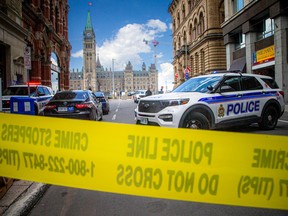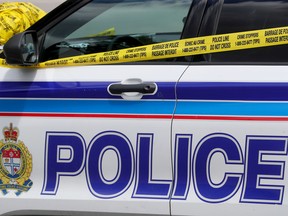According to University of Ottawa professor Michael Kempa, the overall uptick in crimes reported in 2021 in Ottawa is largely a course correction from the downturn created by the pandemic

You’ve no doubt heard the clarion call: Crime is on the rise in Ottawa and someone needs to do something about it — the next mayor, perhaps, if Mark Sutcliffe, the only one of three high-profile mayoral candidates to make crime and safety a featured election platform plank, prevails in that contest. Otherwise, Bytown risks returning to its lawless lumber days.
And there are numbers that support the claim that crime is worsening, so long as you squint your eyes a bit and don’t look too far down.
Sign up to receive daily headline news from Ottawa Citizen, a division of Postmedia Network Inc.
Thanks for signing up!
A welcome email is on its way. If you don't see it, please check your junk folder.
The next issue of Ottawa Citizen Headline News will soon be in your inbox.
Ottawa’s crime rate in 2021 — 3,510 Criminal Code of Canada offences per 100,000 residents reported to Ottawa police — was 6.8 per cent higher than it was in 2020. The violent crime rate went up 5.5 per cent in that period. The rate of non-violent crimes rose by 7.2 per cent. The Crime Severity Index, which measures the seriousness of reported offences, went up by 3.6 per cent. About the only thing that went down was the police clearance rate, falling from 33.7 per cent in 2020 to 31.8 per cent last year. We clearly need a larger police budget to put more boots on the ground or in cruisers, right?
But hang on. If you compare last year’s figures to those from a year earlier — 2019, before COVID-19 relegated residents to their homes — you see a very different picture: The overall crime rate in the past two years has dropped by 17.3 per cent, with the rate of violent crimes down 10.2 per cent and non-violent ones down 18.9 per cent. The Crime Severity Index also dropped, by 12.4 per cent. About the only thing that worsened over that two-year period was, again, the police clearance rate.
Meanwhile, the 15 Criminal Code violations that resulted in death in Ottawa in 2021 (by such means as murder, manslaughter, infanticide and criminal negligence), while significantly higher than the nine that occurred in 2020, was still one fewer than the annual average over the past six years. In other words, the nine deaths reported in 2020 were an anomaly, not last year’s 15. Additionally, even last year’s higher total suggests that the likelihood of you ever being a victim of such crimes is extremely rare: a one-in-68,000 chance, all other factors being equal — although, of course, they’re not; if you’re at home, in bed, at 2 a.m. on a Saturday night, say, you’ve a much healthier chance of seeing another sunrise than if you were picking random fights with strangers in the ByWard Market.
According to University of Ottawa associate professor of criminology Michael Kempa, the overall uptick in crimes reported in 2021 in Ottawa is largely simply a course correction from the downturn created by the pandemic.
“During COVID and the lockdown of society, property crimes and crimes of interpersonal violence went way down, simply for the reason that, No. 1, the opportunity for property crime went way down. People were at home, literally minding their homes while they were working.”
Lockdowns, he adds, also greatly reduced the amount of personal contact in society. “So all types of random physical violence went way down. You’re not out at the bars, getting into that type of pushy, pushy that happens on Friday evenings. Crimes of opportunity, where people were pickpocketed or held up for cash at an ATM, all went down.”
However, not all crimes abated. The added pressure of lockdowns, he says, led to an increase in incidents of intimate partner violence as well as hate crimes.
“For those who tended to go in that direction, it, unfortunately, called out their worst behaviour,” Kempa says. “People were home with lots of time on their hands, being fed all kinds of conspiracy theories and rhetoric on social media, and they started to contribute to it.
“Now,” he adds, “we are in many important ways getting back out into society and would expect to see a rebound in all of the conventional categories of crime.”
Blanket statements about making the city safe don’t mean much, Kempa notes. “Safe from what, and who must be safe?” he asks. “Because over time, the overall rates of crime are quite constant, but it shifts into different areas, depending on what’s going on in society.”

Indeed, this is reflected in a report, dated Monday, Sept. 26, from acting police chief Steve Bell to the Ottawa Police Services Board. In it, he cites shoplifting and gas theft as major contributors to a 24-per-cent second-quarter year-to-year increase in reported crimes. These crimes, perhaps tied to rising inflation, aren’t victimless, but they’re not the first that come to mind in keeping safety-minded residents up at night. Note, too, that the increase, according to Bell’s report, brings the “metric in line with historical levels.”
It’s easy to seize on safety as an election issue, especially given the recent high-profile cases of mass violence in Canada, which Kempa describes as outlier cases and a symptom of a society that hasn’t been functioning normally in recent years. Who, after all, ISN’T in favour of a safer community? It’s like naming a piece of legislation the Bill for Prosperity for Canadian Families.
“Nobody in their right mind would be against these statements,” Kempa says. “It’s the details. And, if you say, ‘Well, we’re going to clamp down and come up with a policy to make Ottawa streets safer,’ there really is no specific police program that you would run that, by itself, would just make the streets safer. Any particular program you run could have an impact on some specific category of crime. So you’d have to be specific. Rather than give the general statement, politicians should tell us which categories of crime are the problem and what their plan is to tackle them.”
In 2019, the province mandated that municipalities prepare and adopt a Community Safety and Well-being Plan. Ottawa’s cites six priorities: discrimination, marginalization and racism; financial security and poverty reduction; gender-based violence against women; housing; integrated and simpler systems; and mental well-being. Among the plan’s nearly three dozen proposed outcomes are seeing fewer people requiring food banks, improving access to supports for survivors of gender-based violence and reducing the number of mental health crisis calls handled by the Ottawa Police Service.
But the plan, Kempa says, like those in many municipalities, is long on platitudes and slogans and, so far, short on specifics.
“Any mayoral candidate who doesn’t have a plan for community safety and well-being is not yet prepared to be mayor. That’s a major file on every mayoral candidate’s desk. So what’s the plan? Who’s going to pay for it? How are you going to get the province to contribute? Are there federal grants available? Because there’s absolutely no way that the municipal tax base could fund these kinds of plans that have been developed in principle, but not in detail. So what is the detailed plan, other than, ‘I’m in favour of community safety?’”
bdeachman@postmedia.com
-

OPP ask for public's help after officer airlifted to Ottawa hospital following incident
-

Bradley and Waller: Ottawa needs to invest in proven crime prevention techniques


